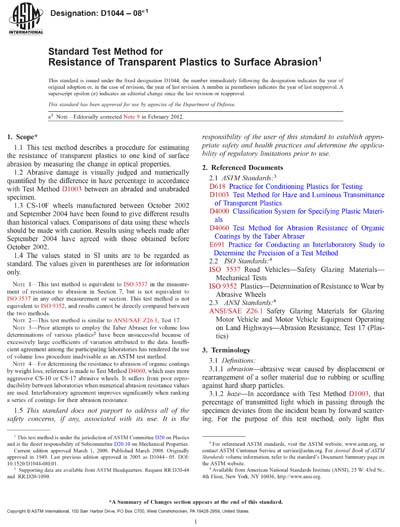Historical
ASTM D1044-08e1
Standard Test Method for Resistance of Transparent Plastics to Surface Abrasion
1.1 This test method describes a procedure for estimating the resistance of transparent plastics to one kind of surface abrasion by measuring the change in optical properties.
1.2 Abrasive damage is visually judged and numerically quantified by the difference in haze percentage in accordance with Test Method D1003 between an abraded and unabraded specimen.
1.3 CS-10F wheels manufactured between October 2002 and September 2004 have been found to give different results than historical values. Comparisons of data using these wheels should be made with caution. Results using wheels made after September 2004 have agreed with those obtained before October 2002.
1.4 The values stated in SI units are to be regarded as standard. The values given in parentheses are for information only.
Note 1—This test method is equivalent to ISO 3537 in the measurement of resistance to abrasion in Section 7, but is not equivalent to ISO 3537 in any other measurement or section. This test method is not equivalent to ISO 9352, and results cannot be directly compared between the two methods.
Note 2—This test method is similar to ANSI/SAE Z26.1, Test 17.
Note 3—Prior attempts to employ the Taber Abraser for volume loss determinations of various plastics have been unsuccessful because of excessively large coefficients of variation attributed to the data. Insufficient agreement among the participating laboratories has rendered the use of volume loss procedure inadvisable as an ASTM test method.
Note 4—For determining the resistance to abrasion of organic coatings by weight loss, reference is made to Test Method D4060, which uses more aggressive CS-10 or CS-17 abrasive wheels. It suffers from poor reproducibility between laboratories when numerical abrasion resistance values are used. Interlaboratory agreement improves significantly when ranking a series of coatings for their abrasion resistance.
1.5 This standard does not purport to address all of the safety concerns, if any, associated with its use. It is the responsibility of the user of this standard to establish appropriate safety and health practices and determine the applicability of regulatory limitations prior to use.
ASTM International [astm]

